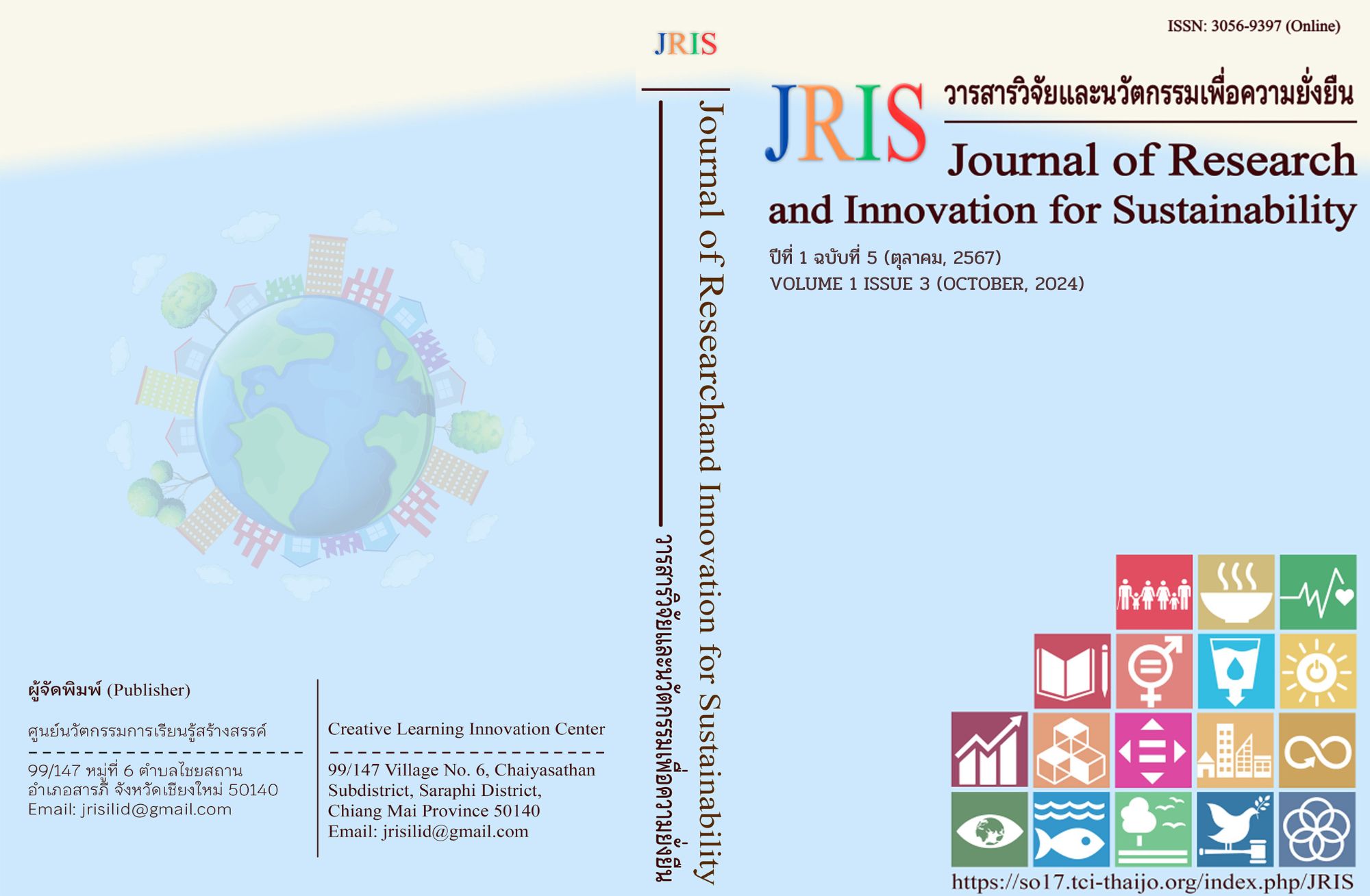THE EFFECTIVENESS OF ACTIVE LEARNING WITH CHINESE VOCABULARY FLASHCARDS TO DEVELOP ACADEMIC ACHIEVEMENT CHINESE VOCABULARY OF STUDENTS FOR 6TH GRADE AT ANURAJAPRASIT SCHOOL IN NONTHABURI
Main Article Content
Abstract
This study aimed to 1) compare the achievement of learning stages in Chinese vocabulary between active learning with Chinese vocabulary flashcards and the criterion of 70 percent of the full score. And 2) to investigate the level of satisfaction the experimental group students were with what they had learned through active learning with Chinese vocabulary flashcards. Sample group including 30 students for 6th Grade Class 1 at Anurajaprasit School in Nonthaburi, selected by lottery random sampling. The instruments used in the study were the learning plan, Chinese vocabulary flashcards, the learning achievement test, and a form for assessing satisfaction. The statistics used. Basic statistics used in this research include percentage, mean, and standard deviation. The statistic used to analyze the experimental results is the t-test. The results showed that 1) The scores of students after using active learning with Chinese vocabulary flashcards were higher than criterion set at 70% of the full score at the 0.05 level of statistical significance. And 2) Students who used Active Learning with Chinese Vocabulary Flashcards reported good satisfaction, with a mean score of 4.07 (SD = 1.09).
Article Details

This work is licensed under a Creative Commons Attribution-NonCommercial-NoDerivatives 4.0 International License.
Copyright License
Permission is granted to use text, content, images, or any other material from the publication for anyone who wishes to read, download, copy, distribute, print, search, or link to the full text of the article, compile data for indexing, transfer data to software, or use for any other legal purposes, provided that it is not used for commercial purposes or for business benefit. All articles published in the Journal of Research and Innovation for Sustainability are distributed under a Creative Commons Attribution-NonCommercial-NoDerivatives 4.0 International License: https://creativecommons.org/licenses/by-nc-nd/4.0/
References
Abbasian, G. (2016). The Effect of Flash Card-based Instruction on Vocabulary Learning by EFL Learners. International Journal of Humanities and Cultural Studies, 3(1), 1929–1938. https://www.academia.edu/114971859/The_Effect_of_Flash_Card_based_Instruction_on_Vocabulary_Learning_by_EFL_Learners
Aliponga, J. & Johnston, C.C. (2013). Benefits of Using Vocabulary Flash Cards in an EFL Classroom. 关西国际大学研究纪要, 14, 1-6. https://kuins.repo.nii.ac.jp/records/365
Creswell, J. (2014). Research Design: Qualitative, Quantitative, and Mixed Methods Approaches (4th ed.). https://spada.uns.ac.id/pluginfile.php/510378/mod_resource/content/1/
creswell.pdf
Demirciogul, S. (2010). Teaching English vocabulary to young learners via drama. Procedia Social and Behavioral Sciences, 2(1), 439–443. https://doi.org/10.1016/j.sbspro.2010.03.039
Haiyudi H., Art-in, S. and Luanganggoon N. (2021). Synectics with Flashcards Functioning to Improve Students Writing Skill of Bahasa Indonesia in Khon Kaen University, UNNES-TEFLIN National Seminar, 4(1), 111-119. https://www.researchgate.net/publication/352864458_SYNECTICS_WITH_FLASHCARDS_FUNCTIONING_TO_IMPROVE_STUDENTS'_WRITING_SKILL_OF_BAHASA_INDONESIA_IN_KHON_KAEN_UNIVERSITY
Johnson, D., Johnson, R. and Smith, K. (2006). Active learning: cooperation in the college classroom. (3rd ed.). Interaction Book Company.
Lee, s. (1961). Knowledge and Teaching: Foundations of the New Reform. Harvard Educational Review, 57(1), 1-22. https://people.ucsc.edu/~ktellez/shulman.pdf
Likert, R. (1961). New Pattern of Management. McGraw Hill.
Wulandari, E. & Chadafi, M. (2022). The Effectiveness of Using Flashcards on Teaching English Vocabulary. JEET, Journal of English Education and Technology, 2(04), 522 - 531. http://jeet.fkdp.or.id/index.php/jeet/article/view/58
Youngciety. (2562, October 28). Flash Cards. Youngciety. https://www.youngciety.com/article/learning/flash-cards-for-kids.html
Freeman, S., Eddy, S. L., McDonough, M., Smith, M. K., Okoroafor, N., Jordt, H., & Wenderoth, M. P. (2014). Active Learning Increases Student Performance in Science, Engineering, and Mathematics. Proceedings of the National Academy of Sciences, 111(23), 8410-8415. https://www.researchgate.net/publication/262267588_Active_Learning_Increases_Student_Performance_in_Science_Engineering_and_Mathematics
กระทรวงศึกษาธิการ. (2560). หลักสูตรแกนกลางการศึกษาขั้นพื้นฐาน พ.ศ. 2551 (ปรับปรุง พ.ศ. 2560). สำนักวิชาการ สำนักงานคณะกรรมการการศึกษาขั้นพื้นฐาน. http://academic.obec.go.th/images/document/1559878925_d_1.pdf
จุราภรณ์ ปฐมวงษ. (2563). การพัฒนารูปแบบการเรียนรู้เชิงรุก (Active Learning) เพื่อส่งเสริมทักษะการพูด สนทนาภาษาอังกฤษ สำหรับนักเรียนชั้นมัธยมศึกษาปีที่ 3. Journal of Modern Learning Development, 7(4), 143-159.
ธิติวัฒน์ ตันติยนุกูลชัย และคณะ. (2565). การพัฒนาทักษะการจำคำศัพท์ภาษาญี่ปุ่น โดยใช้เทคนิคช่วยจำแบบใช้รูปภาพเป็นสื่อของนักเรียนชั้นมัธยมศึกษาปีที่ 4 โรงเรียนเดชะปัตตนยานุกูล.วารสารวิชาการ สถาบันวิทยาการจัดการแห่งแปซิฟิค, 8(3), 525-534.
นพพล จันทร์กระจ่างแจ้ง และสันติพงษ์ ทองดี. (2565). ที่ศึกษาการพัฒนาทักษะการจดจำคำศัพท์ภาษาจีนของนักเรียนชั้นมัธยมศึกษาปีที่ 5 โดยใช้การจัดการเรียนรู้แบบกลวิธีลินซ์ควบคู่กับการจัดการเรียนรู้แบบกระบวนการกลุ่ม. วารสารมหาวิทยาลัยราชภัฏยะลา, 17(3), 33-42. https://so04.tci-thaijo.org/index.php/yru_human/article/view/250837?_gl=1*1w8g9n9*_ga*MTgyMzExOTQ2LjE3MTIwNTkxMDY.*_ga_PDDBSXG8KH*MTcyNzk2NDg2NC4xMDguMS4xNzI3OTY0OTA3LjAuMC4w
นุชจรีย์ สีแก้ว และจิรายุ วงษ์สุตา. (2563). การพัฒนาการอ่านออกเสียงพยัญชนะภาษาจีนโดยใช้เกมบัตรคำพยัญชนะสำหรับนักเรียนชั้นประถมศึกษาปีที่ 5 โรงเรียนเทศบาล 2 วัดทุ่งสวน จังหวัดกำแพงเพชร. วารสารอักษราพิบูล, 1(1), 27-38.
พิชิต ฤทธิ์จรูญ. (2545). หลักการวัดและประเมินผลการศึกษา (พิมพ์ครั้งที่ 2). เฮ้าส์ ออฟ เคอร์มีสท์.
พีระศิลป์ ศิลปสารท์. (2566). ผลการสอนภาษาจีนด้วยเทคนิคการเรียนรู้แบบร่วมมือบูรณาการการอ่านและการเขียน (CIRC) ร่วมกับเกมที่มีต่อความสามารถในการอ่านและเขียนภาษาจีนของนักเรียนชั้นมัธยมศึกษาปีที่ 1. วิทยานิพนธ์ครุศาสตรมหาบัณฑิต. มหาวิทยาลัยราชภัฏวไลยอลงกรณ์ ในพระบรมราชูปถัมภ์.
วรรณิษา ไวยฉาย. (2565). การจัดการเรียนการสอนภาษาจีนในสถานการณ์ปัจจุบัน: มุมมองของผู้เรียนต่อการพัฒนาสถาบันสอนภาษา. วารสารบัณฑิตศึกษา มหาวิทยาลัยราชภัฏวไลยอลงกรณ์ ในพระบรมราชูปถัมภ์, 16(1), 163-166.
ศนิตา อาร์จอสนีย์ และคณะ. (2565). ที่ศึกษาการพัฒนาแผนการจัดการเรียนรู้คำศัพท์ภาษาจีน เรื่องรอบตัวของฉัน สาระการเรียนรู้ภาษาจีน ชั้นประถมศึกษาปีที่ 3 ด้วยแบบฝึกทักษะประกอบกลุ่มร่วมมือแบบ Jigsaw. วารสารมหาจุฬาตานี ปริทรรศน์, 4(7), 36–43.
สัญญา ภัทรากร. (2552). ผลของการจัดการเรียนรู็อย่างมีชีวิตชีวาที่มีตอความสามารถในการแก้ไขปัญหาและการสื่อสารทางคณิตศาสตร์ของนักเรียนชั้นมัธยมศึกษาปที่ 3 เรื่อง ความน่าจะเป็น. [วิทยานิพนธ์การศึกษามหาบัณฑิต]. มหาวิทยาลัยศรีนครินทรวิโรฒ.
สาธิต โภคี. (2565). ผลการจัดการเรียนรู้ด้วยเทคนิคการใช้บัตรคำศัพท์เพื่อส่งเสริมการเรียนรู้คำศัพท์และความคงทนในการจำคำศัพท์ภาษาอังกฤษของนักเรียนชั้นประถมศึกษาปีที่ 5. [วิทยานิพนธ์ศึกษาศาสตรมหาบัณฑิตมหาบัณฑิต]. มหาวิทยาลัยศิลปากร.
สาริศ ศรีระวัตร. (2565). การพัฒนาผลสัมฤทธิ์ในการเรียนรู้ด้านการจำคำศัพท์ภาษาอังกฤษด้วยเทคนิคการเรียนรู้ แบบ Team – Game –Tournament (TGT) ร่วมกับ Blooket ของนักเรียนชั้นประถมศึกษาชั้นปีที่ 6 โรงเรียนอนุบาลพิจิตร. [วิทยานิพนธ์การศึกษามหาบัณฑิต]. มหาวิทยาลัยนเรศวร.
สำนักงานคณะกรรมการพัฒนาการเศรษฐกิจและสังคมแห่งชาติ. (2562). ยุทธศาสตร์ชาติระยะ 20 ปี (พ.ศ. 2561-2580) (พิมพ์ครั้งที่ 2). สำนักงานเลขานุการของคณะกรรมการยุทธศาสตร์ชาติ.
สำนักงานเลขาธิการสภาการศึกษา. (2560). แผนการศึกษาแห่งชาติ พ.ศ. 2560 – 2579. พริกหวานกราฟฟิค จำกัด.
สุวิทย์ มูลคำ และคณะ. (2554). การจัดกิจกรรมการเรียนรู้ที่เน้นการคิด. อี เค บุ๊ตส์.
อารยา คนไว และจิตราภรณ์ วงศ์คำจันทร์. (2566). การพัฒนาการจัดการเรียนรู้แบบร่วมมือโดยใช้เทคนิคจิ๊กซอว์ร่วมกับบัตรคำศัพท์เพื่อส่งเสริมความสามารถการอ่านคำศัพท์ภาษาจีนสำหรับนักเรียนชั้นมัธยมศึกษาปีที่ 1. วารสารมหาวิทยาลัยราชภัฏมหาสารคาม, 18(2), 180-190.

